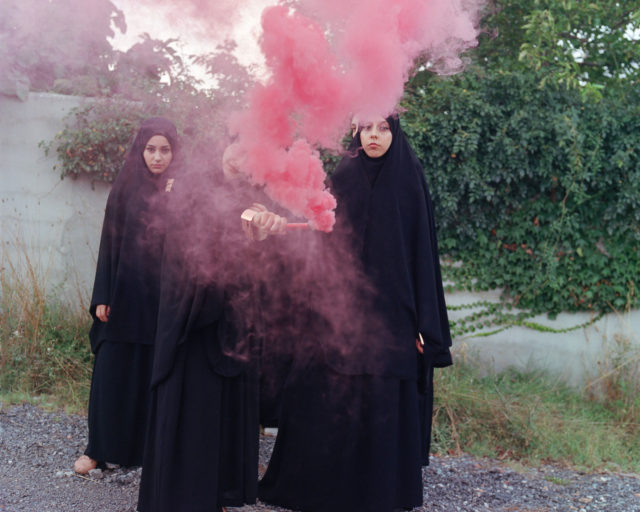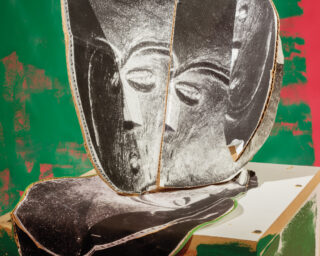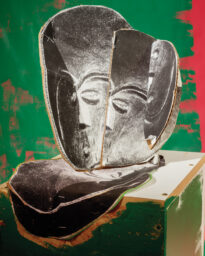Along the Shores of the Caspian
Chloe Dewe Mathews, A woman and her granddaughter sit on the artificial seawall, a few yards from the Iranian border. Astara, Azerbaijan, 2010
What was this?
At the start of my traveling life and journalistic career, in 2001, I dipped my toes into the waters of the Caspian Sea, in an attempt to recover from a weekend spent on the Iranian coast in a rambling house in a gated community. Opium and hash smoke filled the air, and alcohol flowed freely in large gatherings that tried to circumvent the regime’s strict rules. At the edge of the sea, I felt a kind of oily substance, a thick, briny, lukewarm liquid, so unlike the clean and bracing water surrounding the North Sea island where I grew up. A woman, completely covered, was bathing a little farther down the beach in the ripples that constitute the surf there. I looked out across the sea and contemplated the treasures on the other shore: the legendary city of Baku, surrounded by oil fields; strict, isolated Turkmenistan; the gateway to the Caucasus at Derbent; and the endless steppes of Russia and Kazakhstan, with the countless mouths of the Volga Delta in between.
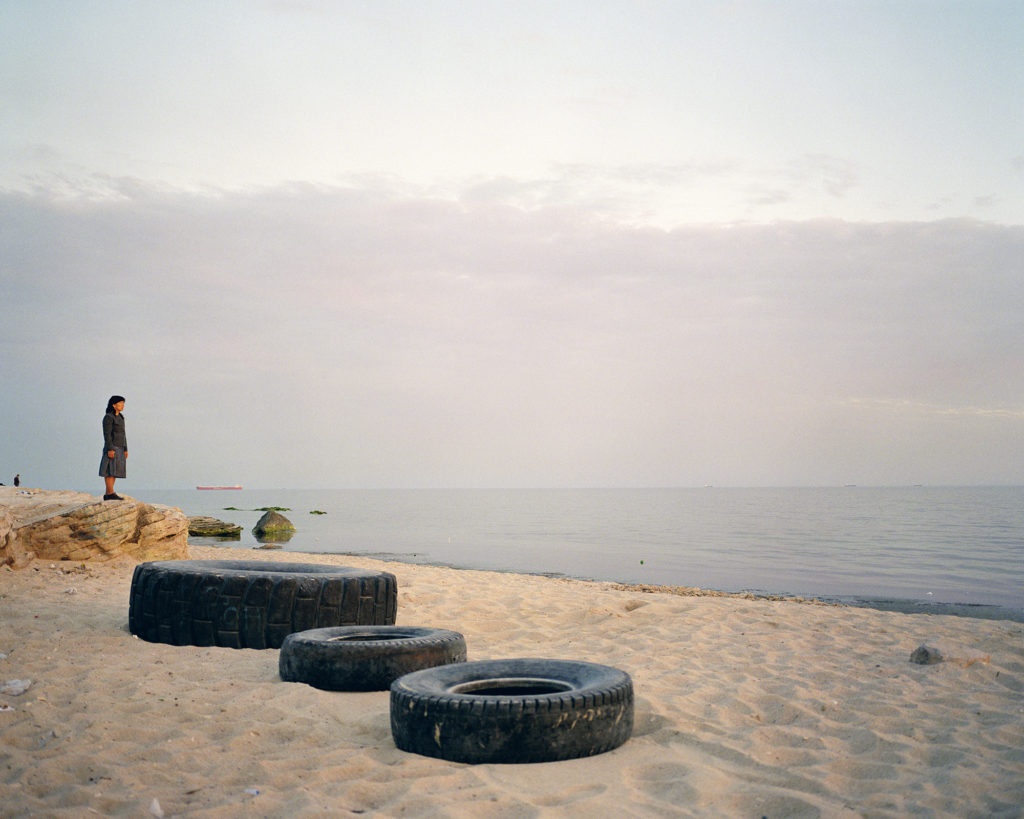
Seas ignite wanderlust. A toe in the water is a connection to the opposite shore, even if it is miles away. As a child I used to stand on the North Sea beach and imagine Iceland on the horizon, taste the molecules from the Sargasso Sea, and feel the chill from the Arctic Ocean. In my imagination I saw the opal-blue waters of Fiji flecking the gray seas of the north. Here, on a beach in Iran, I wanted to go to Russia, to the fairy tales of Central Asia, and see how this sea influences the peoples on its shores. Chloe Dewe Mathews did just that and discovered that although the sea is relatively small, and its coasts might seem worlds apart, the countries are bound together.
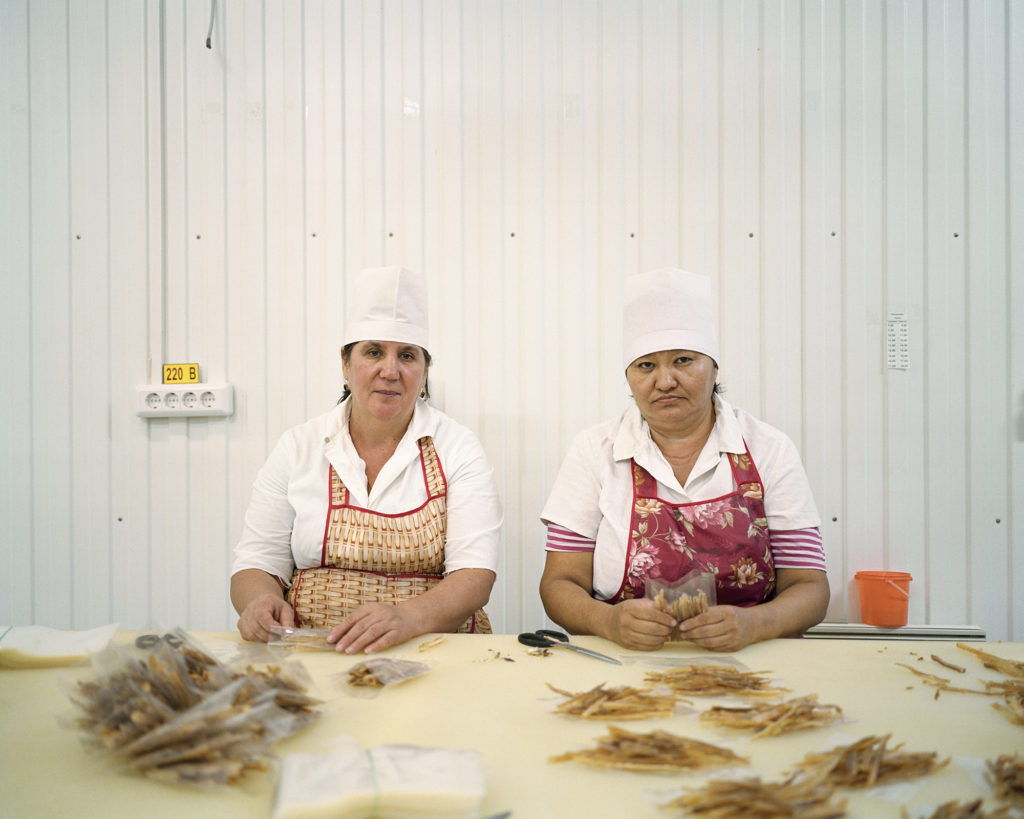
A short distance to the north, the Caspian Sea becomes lighter, sweeter, fresher. Standing on the beach on the Russian side you can see the ferries attempting the crossing, the freighters ploughing through the water. I imagine myself as a small dot on a zoomed-out map of the world, standing next to an apparently insignificant sea without an exit, without perspective. The Caspian Sea is an anomaly, a self-contained system. All the water from Russia’s mighty Volga, which is Europe’s largest river, flows endlessly into the sea, heavy with historical and cultural significance, eventually breaking on the shores of Iran and Turkmenistan and evaporating. The sea acts as an enormous engine, transforming all it touches into steam and salt.
Hard, almost ruler-straight borders divide the land around the sea into fifths, although what these borders have to do with any kind of reality remains a mystery. The borders in this region should be as fluid as its peoples. The dozens of tribes from the Caucasus, the nomads from the Russian steppes, Kazakhstan, and beyond are the result of thousands of years of migration, conflict, and the rise and fall of empires. If you fast-forwarded through the tribal history of the countries surrounding the Caspian Sea, you would see the different peoples washing over the land in waves. From the east came the Tartars, the Mongols, and the Turks, from the south came the Persians, from the north the Cossacks and the Russians. National borders have existed for less than a century. Access to water and, in the last hundred years, to oil and gas are the only real, literally fluid borders that count here.
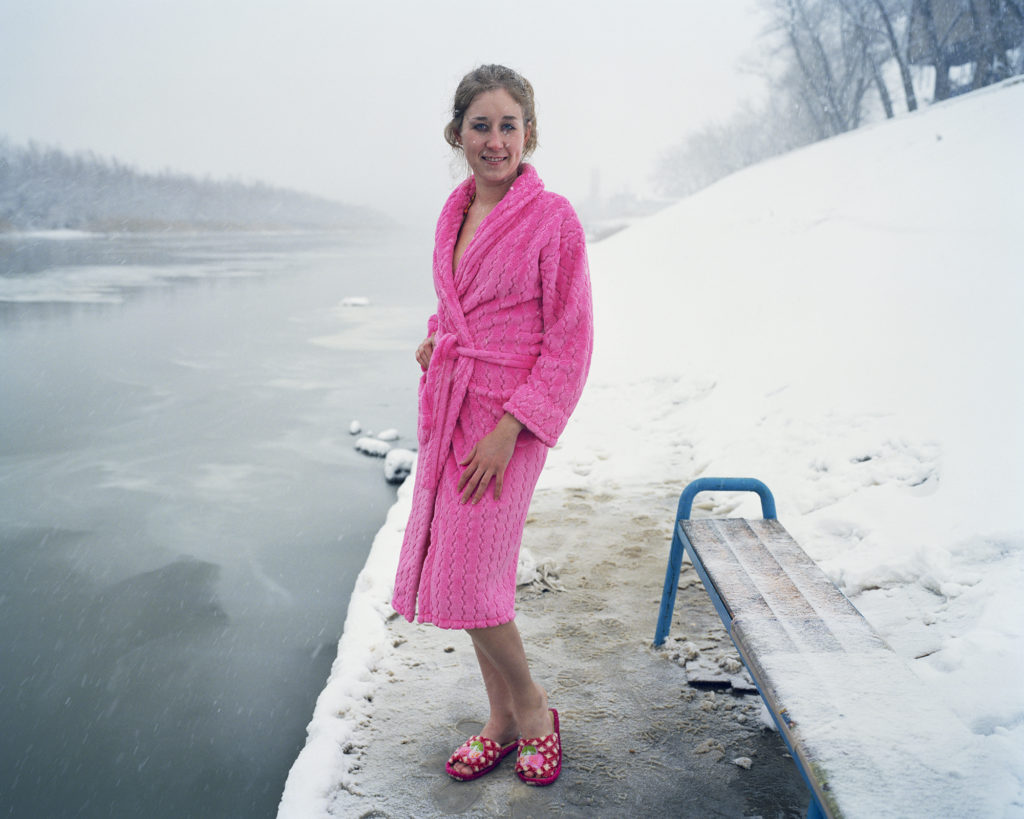
The Caspian Sea has never belonged to anyone, unlike the Mediterranean Sea, which the Romans called Mare Nostrum (Our Sea), or the Black Sea, which the Ottoman Empire ruled in various constellations. Russia has never completely owned the Caspian, although it has come close. Neither the Persians nor the Turks have ever ruled it. Genghis Khan’s nomads got the farthest, but even they never conquered the Caucasus, which the Russians have managed to do to a greater or lesser extent over the last 250 years. The sea belongs to no one—or at least, which part belongs to whom is still under dispute. Despite years of negotiations, the five countries around the sea have failed to reach an agreement. Envy and geopolitics surrounding oil and gas dominate the water. Is the Caspian a lake or a sea? The countries disagree. If it is officially a sea, Turkmenistan, according to international law, may lay an underwater pipeline to Azerbaijan. If it is a lake, then Russia remains the most important transit country for oil and gas. In a complicated game of chess between the five countries, with Russia and Iran at the fore, this body of water’s fate hangs in the balance.
The Caspian Sea is a place of real-life fairy tales. One of these can be found about halfway down the west coast, on the southern border of the Russian Federation, in the autonomous Republic of Dagestan. Here lies Derbent, one of the oldest cities in the world. Embroiled in a fight between trade (as Russia’s gateway to the East) and separatism and Islamic terrorism, it is a city of faded glory, of tensions and uncertainty. But what a city! To the west rise the hills and then the mountains of the Caucasus, the highest mountain range in Europe. Look carefully and you can see traces of the city even in the mountains, like long arms trying to pull passing travelers into its embrace. At one time there were miles of city walls. Looking down from the castle, you can see more of these arms reaching into the labyrinth of the city below.
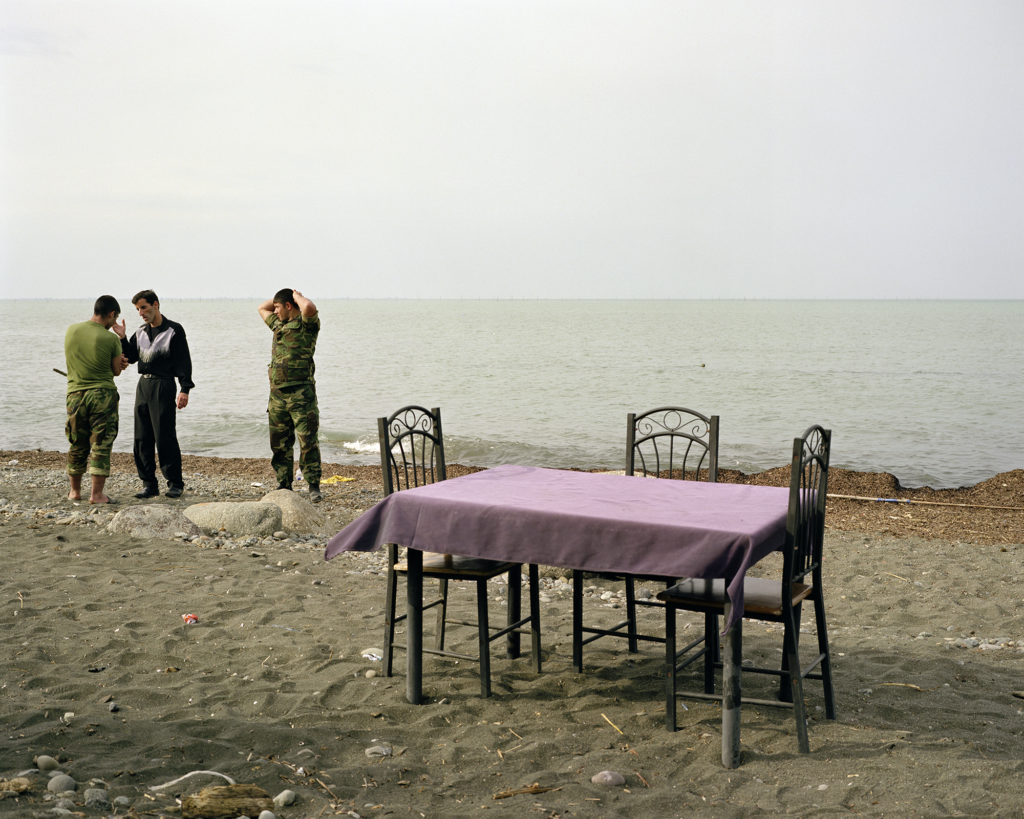
Like a spider, Derbent has woven a web between the sea and the mountains, in order to prevent travelers and, hopefully, any invading army from escaping. The walls that cut through the city do not end at the coast, but march straight into the sea, creating a safe artificial harbor and ensuring no black-market vendor or malicious outsider can pass unnoticed. It’s a city straight off the pages of a children’s storybook, a city just as you would have liked to have drawn it. A city with an oriental history, with a Russian and then a socialist layer laid over it, and where now the messy, random, modern buildings seem to defy any form of logic. A city where the Caspian coast is used as a beach and a bar but also where empty factories, old harbors, and shipwrecks dominate, making their own mountain range of concrete posts, steel hulls, and graffiti, just as in so many other places on the Caspian Sea.
Perhaps the most appealing fairy tale of the region is that of Kara-Bogaz Gol (which literally translates as “black gullet”), the Turkmen sea waterfall through which the Caspian pours and then spreads over a wide bay, where a merciless sun evaporates the water faster than the Volga can replenish it. This has created a fascinating area of extremely salty water, salt pillars, and crystals that the residents eagerly harvest. In his book Engineers of the Soul (2012), Frank Westerman describes the writers who, under Stalin, were meant to prepare the minds of the Soviet citizens for communism. Konstantin Paustovsky, one of the great twentieth-century Russian writers, chose Kara-Bogaz Gol as his topic. In fantastical terms, he cites the many stories about the sea waterfall—how sailors described the coast of Asia as a towering wall and the cascade as a maelstrom. A “sea waterfall” sounds like a fantasy from the time when the Earth was still considered flat, something that would have been drawn on old maps next to dragons and deep-sea monsters. But in the Caspian Sea, it is reality.

In any other country, you would expect Kara-Bogaz Gol to be a world-famous attraction. Not here. In authoritarian Turkmenistan, you need a special permit to visit. But farther to the south rises a new mythical land: Awaza, Turkmenistan’s answer to Dubai—or “Turkmen Las Vegas,” as Dewe Mathews discovered. Every country around the Caspian Sea would like to copy Dubai’s success, the fairy-tale city rising out of the Arabian desert. Azerbaijan, Chechnya, Georgia, Kazakhstan, Iran, Turkmenistan, and Russia all regard Dubai’s incredible transformation into an ultramodern cosmopolitan metropolis as a rags-to-riches tale worth imitating. In this, everyone believes they have found a unique route to new national success. But construction alone is not enough. In Turkmenistan, the resorts are empty, and the country’s dictatorship stifles the type of freedom found in Dubai, as one of Dewe Mathews’s images attests, featuring a larger-than-life-size portrait of the leader looming in a baroque interior. In the meantime, the world’s greatest inland sea, fed by Europe’s largest river, empties itself desolately over a sea waterfall and into a salt desert.
This Volga is much more than a river. This is Mother Volga, on which nearly all old Russian cities are situated, the lifeblood of the Motherland. Many Russians, rich and poor, travel to the river to eat, drink, and fish. Here, and in the sea, swim the sturgeon from which Russia’s black gold, the coveted roe that makes caviar, can be mined. The Volga Delta, with its thousands of arms and lakes and abundance of birds and animals, is therefore also a perfect place for wealthy Russians to pit their strength against nature. Putin and Medvedev come here for male-bonding weekends and roar up the rivers in motorboats; they fish bare-chested on the bank, organize hunting parties, or dive below the surface to photograph the wildlife, so that the whole of Russia will know their president and prime minister can measure themselves against Mother Volga.
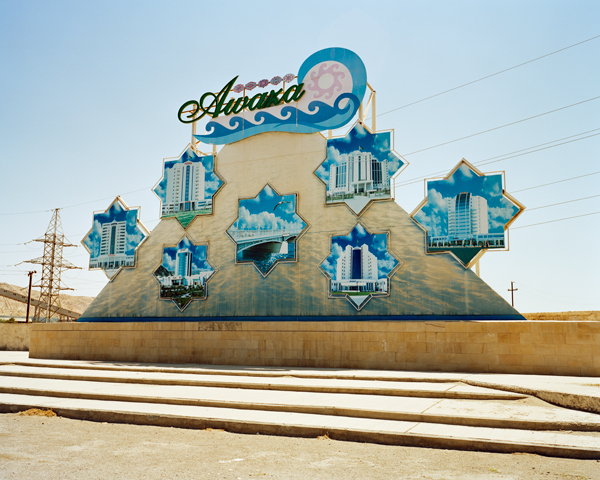
Those in power in the Kremlin form a striking contrast to the inhabitants of the delta and the Caspian coasts, from the extravaganza of Baku, “Turkmen Dubai,” and elite Russian resorts to those of small villages, cities, former Soviet farms, and abandoned factories. Most Caspian residents still live at subsistence level and are self-sufficient; they fish and work their land, and survive the changing regimes. The wide, beckoning sea offers few alternatives on the other sides.
When looking through Dewe Mathews’s work on the Caspian, from its often-impoverished denizens to its decadent visitors, from the worshipping of holy water to its reserves of holy oil, you can’t deny the fact that the Caspian is a magical place. Think about it: when dipping your toes in the water of any sea or lake, there she is, the lady in pink on the other side, dipping hers in the ice-cold water. There are the sunbathers, draping their towels between the rotting concrete remnants of some factory; there are the empty, shiny palaces, misplaced but waiting for those toe-dipping tourists. Seas are magical places. A sea connects cultures, even those that are miles apart. People move close to it, bathe, swim, build ships, start trading, go fishing, and look and sail across and start dreaming away. In the meantime the water flows past in an endless swirl from the Volga to Kara-Bogaz Gol.

All images courtesy the artist, Aperture, and Peabody Museum Press
Just before the Volga pours into the sea, Russian Orthodox state priests declare the Mother River’s water holy. The sins of the past year are washed clean in the ceremony and illnesses disappear while the water, in the harsh Russian climate, undergoes the endless transformation from liquid to ice, from river to sea, from fresh to oily and salty, from seawater to salt desert, and then returns as cloud, rain, and water vapor. The never-ending cycle begins again.
This essay is from Chloe Dewe Mathews: Caspian: The Elements (Aperture and Peabody Museum Press, 2018) and was translated from the Dutch by Alison Eradus.
Chloe Dewe Mathews’s exhibition Caspian: The Elements will be on view at Aperture Gallery from October 25 to November 30, 2018, and at the Peabody Museum of Archaeology & Ethnology, Harvard University, from April 27, 2019 to January 5, 2020.











